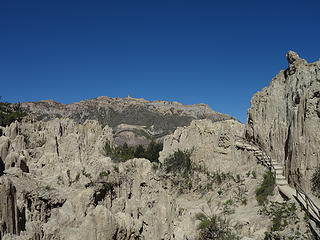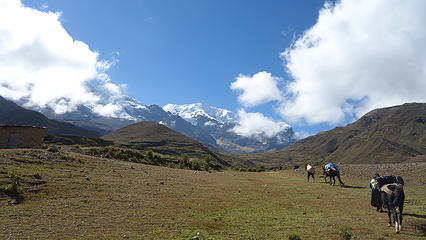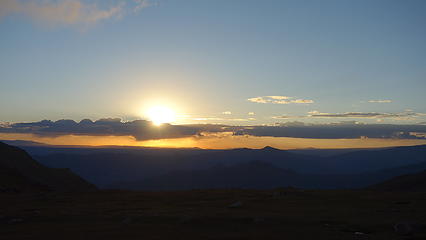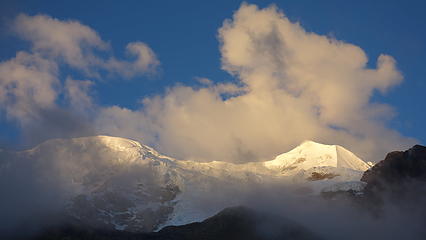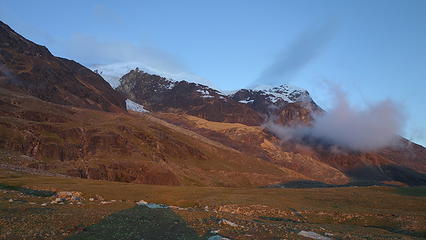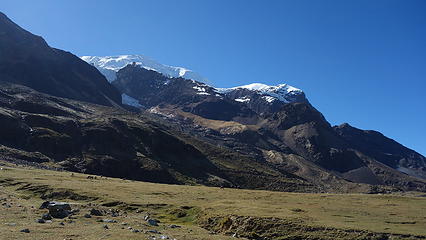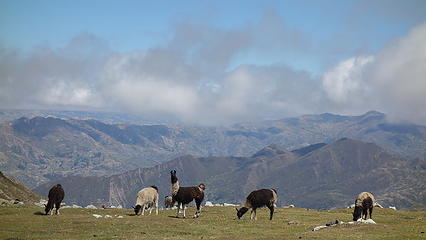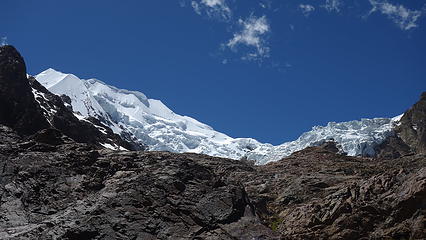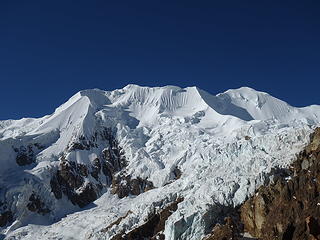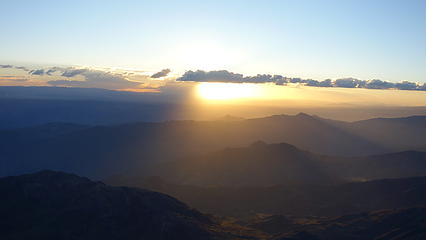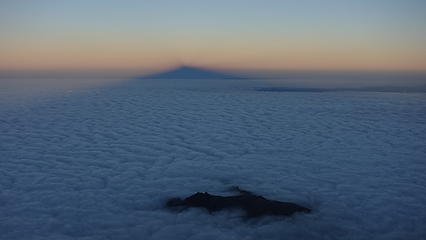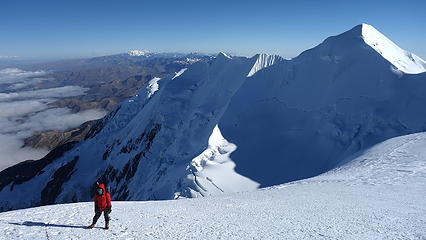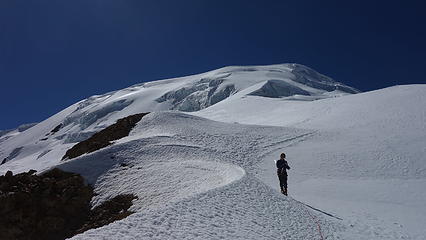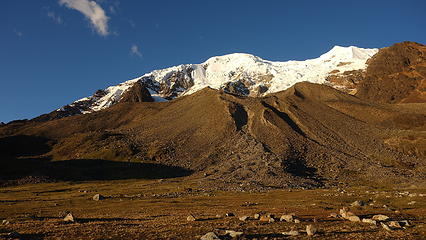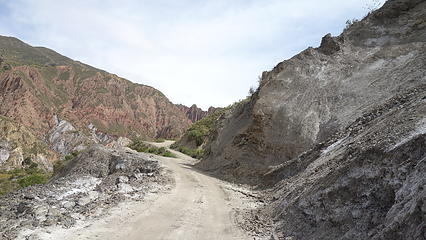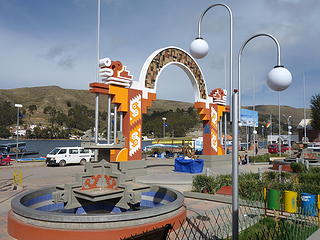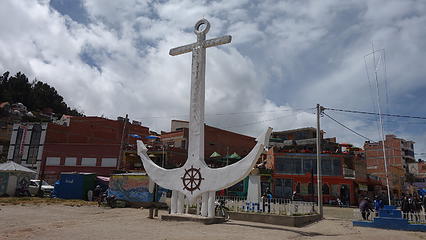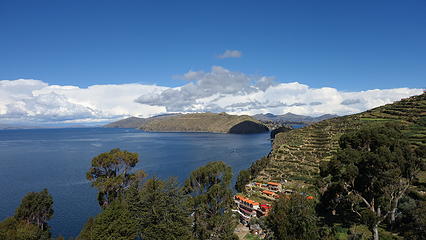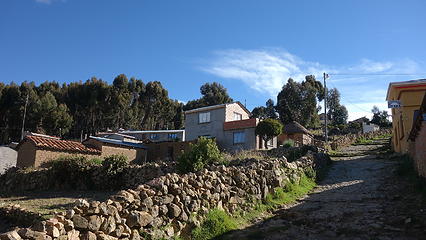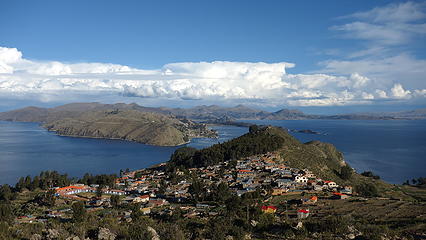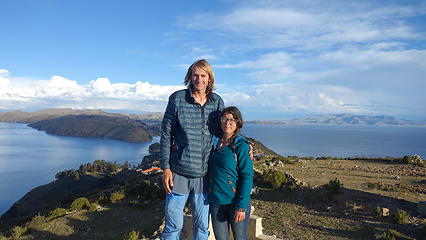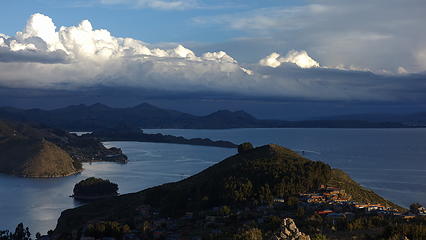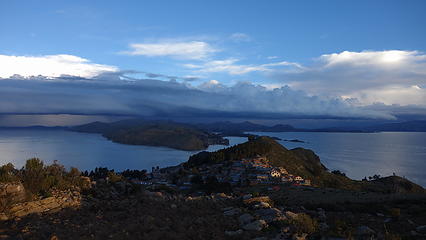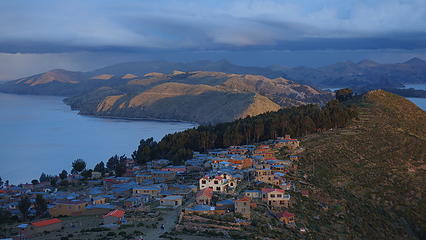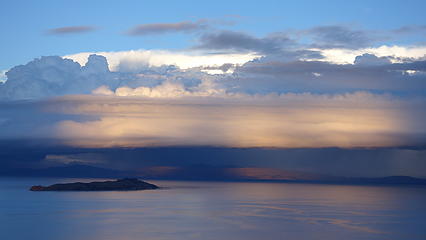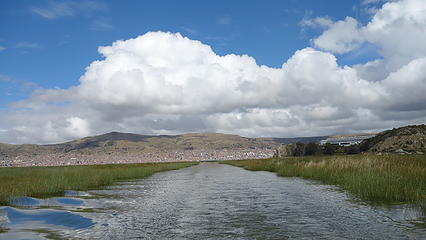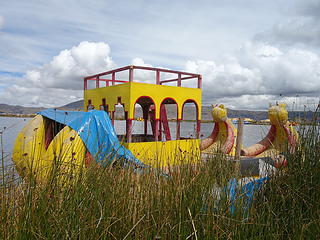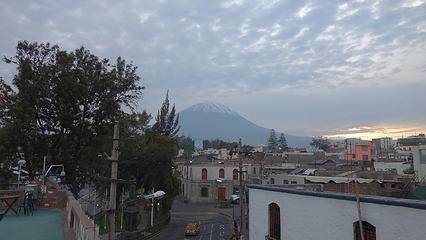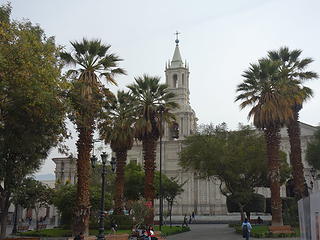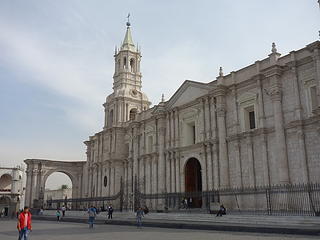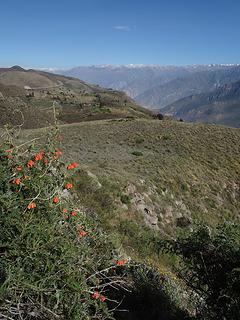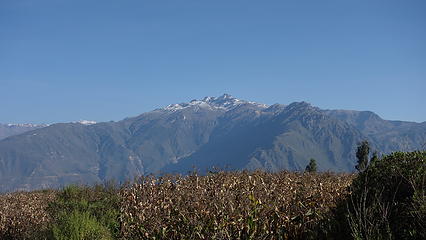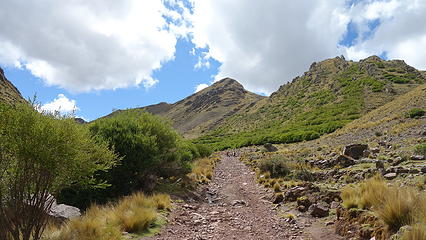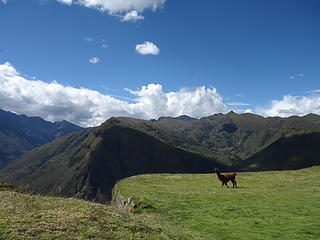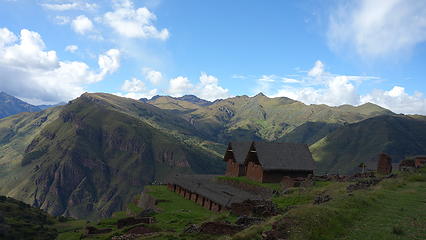Illimani - 21122' - West Ridge
also includes Isla del Sol, Colca canyon, & little cusco
April 2018
Going back now to April 2018, Illimani would be the last big mountain objective Elaine and I would embark on during our 4 months in South America last year. After successfully ascending Pequenyo Alpamayo and Huayna Potosi in the preceding couple weeks, we were finally acclimated enough for Illimani, which sits at at elevation of 6438 meters, which sits just 104 meters lower than Sajama, the highest mountain in Bolivia in a completely different part of the country. Illimani is so special though because it towers so brilliantly above the capitol city of La Paz, and we would see its grandeur every day while exploring around the city. During one of our rest days after Huayna Potosi, I decided to head off with a couple new friends we made from our hostel to Valle de La Luna, which is a small canyon with a maze of deep chasms and hoodoos sitting right next to a nicer neighborhood just south of the La Paz city center. A quick collectivo ride and we were there, and we enjoyed a scenic walk exploring the interesting landforms.
That evening we inquired about how to get to Estancia Una, the tiny village at the base of Illimani about 15 kilometers to the west of the summit of Illimani. We were informed by the guiding agencies that you can take a bus (collectivo) from the area where the market is located near Plaza Marcelo to Estancia Una but it left at some time between 4-6am (super helpful lol). With the agencies charging over $100 each way from La Paz to Estancia Una, we opted to try and find the bus early the next morning. So we ran around Av. Illampu buying all the food we would need for 4-5 days and packing up in our hostel (which was located right at the intersection of Av Illampu and Sagarnaga). We tried to get some sleep but my excitement was too high.
At 3am we woke and ate a quick breakfast before saddling up our packs and heading out to roam the streets of La Paz in the wee hours of night. Perhaps this was only ok since I am so much bigger than Bolivians, however we never encountered any sketchy individuals. Our bigger problem was we continued to roam and roam around asking whoever we saw who was up if they knew where the bus to Pinaya was and as in traditional South American fashion, everyone had a completely different answer! We circled around Plaza Mercelo probably 4 times going to all these different intersections we were directed to go with no luck. As 5:30am rolled past, we were about to give up when by total chance, I saw a collectivo van parked in a small spot just off the road (unfortunately this exact location escapes me) and I went to ask the driver if they were headed to Pinaya and lo and behold he was! He was planning to leave around 6am so we hopped in and secured a couple seats. His price was somewhere around 50 Bolivianos.
The ride over was very scenic, as we were on dirt roads as soon as we left the city proper, which ascended up and over 3 large ridges and contoured above some big valleys. We passed through the town of Palca which was a somewhat larger village about 1 hour from La Paz and continued eastward on at times very narrow and heavily switchbacked roads. People would get off in tiny villages along the way until Elaine and I were the last ones in the van. The driver mentioned he doesn't see travelers often, and was surprised we were taking a collectivo to access Illimani. Upon arriving in Estancio Una at 3620 meters (same elevation as downtown La Paz believe it or not!), there was no one around, but the view of Illimani now towering directly above us was awe inspiring. The glacier clad slopes were massive. The "central" part of this village was merely a small field where the van dropped us off, circled by about 10 small dwellings. There were some kids playing around and when they noticed us with our large packs I think they notified some of the farmsmen with burros because after about 20 minutes a couple guys came up and asked if we wanted burros. We agreed to take the burros to carry our gear to the base camp which is the very large open field called Puente Roto at an elevation of 4450 meters.
The burros were a bit more expensive than we had anticipated, even for just a one way trip ( I think we each paid $25) but to not have to carry 40-50 pounds of gear for the first 800 meters gain would be really nice. So we were loaded up and started up the dirt roads towards Illimani. As we walked through the grazing fields rich with grasses and plants perfect for the various animals the local people raised, Illimani began to show herself more, until at which point after a few hours of walking we arrived at base camp. It's a gigantic field about 400 meters by 600 meters in size. You could quite literally put up 1000 tents! Amazingly, we were the ONLY ones there likely attributed to the fact that April is early season for climbing in the Cordillera Real. With the pretty crazy weather La Paz endured during our 3 weeks visiting the area it was lucky we got good weather for all our summit days. Anyhow, we made up camp and by about 2pm we were relaxing with the sheep and llamas without any other soul around. As the afternoon lighting began to graze the west face of Illimani I couldn't help but take a ton of photos, and also scouted the route up the mountain, which followed the obvious central of 3 west ridges all the way up to the summit ridge. Directly above base camp is the start of the northern of the 3 west ridges which takes you to the lower north summit of Illimani, and while the furthest south of the three west ridges does also lead right to the true summit, it is considerably more technical.
The sun continued to set and we made a filling dinner, as the next day we agreed would likely be the most taxing, as we would have to carry our 40 pound packs up the lower half of the central west ridge, a gain of 1000 meters to a small camp at 5400 meters, which would mark the highest either of us will have ever slept.
The next morning we started hiking the fairly well worn trail towards the base of the central west ridge. The trail ascended gradually and crossed the outwash basin between the northern and central ridges, which had a sizable stream coming down. It was pretty easy getting to the base of the ridge, as the trail followed nice switchbacks up to a small saddle just east of a small rounded knob. Once we crested the ridge, we saw a team of 3 coming down from above. We rested at the ridgecrest awhile until they met up with us, one of which was the guide for the other two. We chatted for a bit about conditions and they continued down. The steepness increased substantially when we started hiking up. While there was still a halfway decent trail on the broad ridge, we did have to at times rock scramble and cross the occasional snowfield since it was early season. With the packs and elevation it wasn't a speedy ascent of 1000 meters but we made it.
Since the typical high camp location was still covered with snow, we stopped about 150 feet below where a tiny flat spot perched on the edge of the abyss on the north side of the ridge offered just barely enough space to pitch the tent. The edge of a large snowfield was directly behind though so the ground was a bit damp from the afternoon sun melting it. With some doctoring I made the spot suitable for the tent. It had taken us probably 4.5-5 hours to ascend to high camp, which was about 5400 meters in elevation. While this was the highest both of us will have ever slept, due to progressively going to higher elevations over the course of the previous month we were ready for it. We hunkered down early since we had a 2:30am wake up call to begin the climb. We enjoyed the views from camp extensively, as this was one of the grandest places I've ever slept.
Around 10pm that evening, a solo hiker came up the ridge and was walking around us, obviously having seen our tent. Knowing there was no other good place to set a tent I assumed he would have to bivy, but to my surprise I heard him pitch his tent...I tried to imagine where and when 2:30am came and we were up I got the answer. He slept on some jagged rocks directly on the crest of the ridge, and his tent looked like a $20 Wal Mart tent! I was impressed haha. We were up before him though, and we started up the ridge at about 3:30am in pitch dark, going up the last 150 feet to the standard high camp location which was arguably the most technical part of the whole climb. With crampons already on, we had some class 3 rock covered with 45 degree firm snow to climb for perhaps 100 feet at which point we emerged onto the flat spot big enough for perhaps a dozen tents or so, however as we were warned it was indeed still snow covered. It was nice carrying the lighter packs for that more difficult stretch though.
Continuing on, we soon stepped onto the permanent snowfields on the central part of the west ridge which were quite mellow for awhile. We made great time through this section and just as we started heading up steeper snow we noticed our solo friend emerge from his tent. The route was fairly easy to follow even in the dark on a very wide ridge. The steepness increased to about 35 degrees for awhile, then eased again and twilight started to lightly illuminate the sky as we neared 6000 meters elevation. Looking up at the remaining mountain ahead it looked pretty easy but the final 450 meters would take us an additional 3 hours! I watched the false summit off to our north as we slowly gained elevation, watching the sunrise ighting grow brighter and brighter and feeling the elevation a bit more. Just as the sun rose with the first rays of light, we reached a fairly flat location at around 6150 meters. Looking up we could see the summit ridge looking so tantalizingly close, but the steepest part of the ascent lie right before us. 200 meters of 45-50 degree snow, with a few large crevasses to navigate around lie ahead. We took a break here in the cold shade to eat and drink and I noticed the solo climber still quite a ways below us. Despite our slow pace, I think we were moving faster than he was, which with his late start I wondered if he would push through late into the afternoon. Since the route went up the west side of the mountain, you can safely climb the route until the early afternoon but by about 3pm the snow softens up and makes travel much more difficult, with potentially the chance to post-hole a bit.
We pushed on and methodically ascended the final steep snow slope to the summit ridge, which we crested at 6350 meters and followed it up to the south. Finally we hit the sun and all that was left was a 100 meter ascent up a very, very gentle ice covered ridge that was wider than a football field. The summit area of Illimani is actually quite massive with three distinct peaks with the south peak being the highest. The east peak became visible once we crested the summit ridge but it's quite a bit lower at 6130 meters, and has its own name known as Layqa Qullu.
It felt like an eternity slogging up this final ridge for a distance of about 400 meters. We were both really feeling the elevation by this point, and I think with the addition of the wind that started howling as soon as we crested the summit ridge, the physical difficulty seemed to increase even though the gradient eased to 15-20 degrees. We could only take perhaps 4-5 steps at a time before having to catch breath, but at a time of 10am, we both stood atop Illimani, which smashed both of our elevation records. We were substantially higher than the low cloud layer that blanketed the landscape well below us, and nearby giants like Huayna Potosi and Illampu to the northwest were also visible.We stayed on the summit only about 10 minutes since it was now difficult to just stand there and breathe! We snapped a few photos and started down. As soon as we started hiking down it was almost an immediate improvement in breathing capacity. It felt like that my body passed an oxygen threshold at like 6400 meters but perhaps that was because I was 350 meters higher than my previous elevation record (which was made on Huayna Potosi just the week before). Regardless, it was a very memorable moment despite the slight misery.
On our descent we passed the solo climber at about 6200 meters...it sounded like he was going to continue to the top so we wished him well and continued down. Descending the 45 degree upper section went smoothly and since we were dropping elevation so quickly I was starting to get a headache so I pressed on as I suggested we take a short nap at the tent before packing up and continuing the hike back to base camp that afternoon. At about noon we reached the tent and rested for an hour. It was really nice to lay down! By about 5pm we had made it back to base camp and pitched the tent one last time during our big South America journey, as the remaining 2 weeks of our trip would be spent playing tourist and doing day hikes as we traveled from La Paz, past Lake Titicaca and Isla del Sol, through Cusco, and on to Lima. Our hike out the following morning was as beautiful as ever as we passed through some small farms and were greeted by families with children just living a simple like at the base of Illimani. They couldn't be happier either which was pleasant to see.
Upon returning to Estancia Una, we were able to catch a collectivo down to the next village, however this was lucky as normally the vans don't run on weekends. There just happened to be a village meeting with locals from all the nearby villages and the best location for it was the field in the next village down, called Quillhuana. Upon reaching this point we were told that a van might take people down to Palca in a couple hours so we patiently waited at the small Plaza de Armas which was supplied with a couple benches and some green grass the size of a standard suburban backyard. There may have been 50 people living here total! After a couple hours though a van did come and we made it to Palca, and since this town is larger, it was east to hop on another van to go back to La Paz. With Illimani complete, Elaine and I both agreed to relax the final 2 weeks of the trip and not climb anything else. After all, we had been more or less roaming the mountains nonstop for over 3 months!
We moved on from La Paz after 3 awesome weeks there climbing 3 major summits in the Cordillera Real, and headed west to Lake Titicaca where we enjoyed the boat ride to Isla del Sol and walked to the high point of the island. We watched a brilliant sunset from this high point with views of the west end of the Cordillera Blanca and the lake surrounding us in all directions. It was super magical. We stayed in a nice hostel that night which unfortunately I somehow got very sick at and throwing up all night. That was the only time I got super sick on the whole trip which I consider myself lucky it happened at the end and not on a mountain! The walk down the hill to the boats the next morning was very hard as I was severely weakened from expelling everything...plus it was pouring rain! We did experienced some local culture and enjoyed the more simple things life has to offer in Bolivia and Peru though, and after leaving Isla del Sol we continued through Puno and on to Cusco.
The remainder of our trip took us through Peru mostly to areas I have been before, but Elaine hadn't. We experienced the straw islands by taking the short boat ride out from Puno and then we bussed to Arequipa which was one of the more enjoyable cities I've ever been to. The Peruvian history here is amazing, and we took one of the city tours and learned a lot. The architecture in Arequipa was very interesting...it is nicknamed the white city and gor good reason. The photos really show what I mean here. We joined one of the Colca Canyon tour hikes which is a typical activity young travelers embark on from Arequipa and it was a fun way to meet other travelers and still get some hiking in (albeit easy for us). The ride from Arequipa to Colca Canyon was very long though, and on our way back we drove through a total snowstorm! That was something our Peruvian guides/driver was not prepared for. Because the road was covered with snow it took 6 hours to drive what only took us 3 to do on the way there.
Continuing on yet another bus to Cusco, Elaine thought about doing the whole Maccu Picchu thing but since I had already done it, and since she didn't feel like the money required was worth it, we instead hiked to a lesser known Inca ruin site called Little Cusco (Huchuy Qosqo) which was actually really great (and a place I hadn't been to). We made a big point-to-point hike with it and was able to take collectivos/taxis to the starting point just outside Chinchero at the end of the road east of Laguna Piruay, and start hiking on a well used trail northeast into a beautiful valley, up to a pass at 4350 metes (see map). We then continued along the trail as we weaved around the gentle hills and passing numerous amazing viewpoints looking north towards the Cordillera Urubamba, which is a mountain range I haven't really climbed in yet. From here it was a long descent eastward down towards the Urubamba River valley. At an elevation of 3650 meters, tucked away in a small flat bench 700 meters above Lamay, we came upon Little Cusco. It's completely hidden from the towns in the valley below and was well worth the visit to explore. We then continued on the main trail that people use to hike up to it and got on another van in Lamay to take us back to Cusco It was a great way to spend a day in Cusco and explore a large area.





